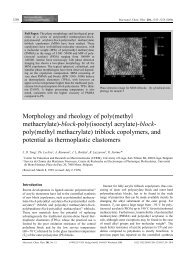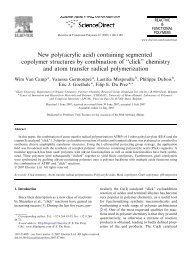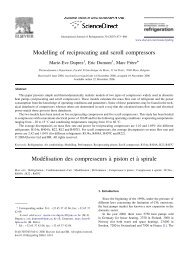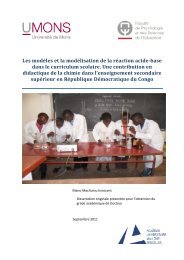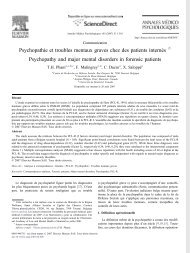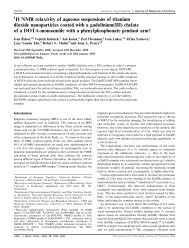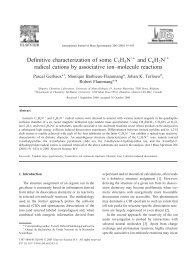Using JCP format - Université de Mons
Using JCP format - Université de Mons
Using JCP format - Université de Mons
Create successful ePaper yourself
Turn your PDF publications into a flip-book with our unique Google optimized e-Paper software.
J. Chem. Phys., Vol. 112, No. 19, 15 May 2000 Hexa-functionalized C 60 <strong>de</strong>rivatives<br />
8559<br />
TABLE I. AM1-calculated bond lengths in angstrom in the functionalized<br />
part of the C 60 <strong>de</strong>rivatives. The bond labeling refers to that given in Fig.<br />
1e. We also report in parentheses the experimental bond lengths in<br />
C 60 Ph 5 OH provi<strong>de</strong>d by x-ray diffraction experiments Ref. 34.<br />
C 60 Cl 6 C 60 Ph 5 Cl C 60 Ph 5 H<br />
C 60 Ph 5 OH<br />
isomer 1<br />
C 60 Ph 5 OH<br />
isomer 2<br />
a 1.368 1.368 1.368 1.366 1.369 1.367<br />
b 1.530 1.536 1.537 1.536 1.550 1.539<br />
c 1.532 1.538 1.540 1.538 1.542 1.535<br />
d 1.368 1.368 1.369 1.367 1.358 1.366<br />
e 1.539 1.546 1.545 1.546 1.544 1.547<br />
f 1.527 1.534 1.536 1.533 1.543 1.532<br />
g 1.364 1.364 1.366 1.368 1.364 1.368<br />
h 1.529 1.535 1.532 1.537 1.530 1.522<br />
i 1.547 1.551 1.540 1.561 1.581 1.572<br />
j 1.539 1.539 1.527 1.548 1.556 1.558<br />
k 1.490 1.497 1.496 1.501 1.511 1.498<br />
l 1.367 1.368 1.370 1.368 1.339 1.373<br />
m 1.472 1.476 1.472 1.475 1.471 1.469<br />
n 1.493 1.501 1.499 1.500 1.523 1.502<br />
h 1.645<br />
nounced for the asymmetric C 60 Ph 5 OH isomer 2 and is<br />
very weak for C 60 Cl 6 . The latter result confirms the small<br />
electron donation from the cage to the chlorine atoms. Both<br />
the functionalized and unmodified parts of the cage in<br />
C 60 Ph 5 Cl and C 60 Ph 5 H where the global electron-donating<br />
character of the functional groups is strongest have an excess<br />
charge. In contrast, the functionalized part of the cage<br />
also acts as an electron donor in the case of the C 60 Ph 5 OH<br />
isomers.<br />
The graphical representations of the HOMO and LUMO<br />
orbitals of each <strong>de</strong>rivative are shown in Fig. 2 together with<br />
the corresponding participation number PN calculated using<br />
Eq. 1. Figure 2 clearly illustrates that the functional<br />
groups weakly contribute to the molecular orbital <strong>de</strong>scription<br />
of the frontier levels provi<strong>de</strong>d that the C s or pseudo-C s symmetry<br />
is preserved. This is particularly true for the HOMO<br />
orbitals of the symmetrical and pseudosymmetrical hexafunctionalized<br />
<strong>de</strong>rivatives, which are mostly localized on the<br />
equatorial belt in agreement with earlier theoretical results<br />
reported for C 60 Ph 5 K complexes 66 and are characterized by<br />
a very similar participation number: 42.20.5. The LUMO<br />
levels of these <strong>de</strong>rivatives are also localized on the unmodified<br />
part of the C 60 cage but present larger fluctuations in the<br />
PN varying from 44.6 to 58.1. The reduction in symmetry<br />
in going from the pseudo-C s symmetrical C 60 Ph 5 OH isomer<br />
1 to the asymmetric isomer 2, significantly modifies the<br />
characteristics of both the HOMO and LUMO orbitals. This<br />
is illustrated by the fact that the frontier orbitals of the asymmetric<br />
C 60 Ph 5 OH gain significant weight on the carbon atoms<br />
forming the ‘‘functionalized part’’ of the cage, where<br />
the HOMO level is mostly localized with a PN of only<br />
22.1.<br />
The ionization potential I and electron affinity A<br />
evaluated with Koopmans’ approximation, correspond in absolute<br />
value to the Hartree–Fock energy of the HOMO and<br />
LUMO levels, respectively. The difference I-A represents<br />
the HOMO–LUMO gap (E), which is a useful parameter<br />
when analyzing the spectroscopic properties of the fullerence<br />
<strong>de</strong>rivatives, as shown later. The values of I, A, and E calculated<br />
at the semiempirical AM1 and INDO/S level for each<br />
<strong>de</strong>rivative are collected in Table II. The comparison between<br />
the calculated values and the experimental data reported for<br />
C 60 in the gas phase I7.610.02 eV 67 and A2.65<br />
0.05 eV 68 indicates that the INDO/S method yields a<br />
somewhat more accurate estimate of the first ionization potential<br />
although it does not reproduce the value of the electron<br />
affinity as well as the AM1 method. The shifts in the<br />
HOMO and LUMO levels energies provi<strong>de</strong>d by the two approaches<br />
are very similar when going from one functionalized<br />
<strong>de</strong>rivative to the others; a <strong>de</strong>tailed analysis reveals, however,<br />
that the balance between the -acceptor inductive vs<br />
-donor mesomer characters is subject to variations between<br />
the INDO/S and AM1 parametrizations, <strong>de</strong>spite the fact that<br />
TABLE II. Ground-state properties heat of <strong>format</strong>ion H f , charge distribution, ionization potential I, electron affinity A, and HOMO–LUMO gap E of<br />
the C 60 <strong>de</strong>rivatives, as calculated at the AM1 level. We provi<strong>de</strong> the total Mulliken net charges supported by the functional groups as well as by the<br />
‘‘functionalized’’ summed over 20 carbon atoms and ‘‘unmodified’’ summed over 40 carbon atoms parts of the molecule. The INDO/S values calculated<br />
for I, A, andE are also given in parentheses.<br />
C 60 C 60 Cl 6 C 60 Ph 5 Cl C 60 Ph 5 H<br />
C 60 Ph 5 OH<br />
isomer 1<br />
C 60 Ph 5 OH<br />
isomer 2<br />
H f kcalmol 1 974 847 1016 1010 981 1007<br />
Charge distribution (e) 0.007/Cl on C1 0.044/Ph on C1 0.019/Ph on C1 0.070/OH on C1 0.010/Ph on C1<br />
0.006/Cl on C2 0.044/Cl on C2 0.217/H on C2 0.029/Ph on C2 0.028/Ph on C2<br />
0.001/Cl on C4 0.036/Ph on C4 0.028/Ph on C4 0.037/Ph on C4 0.031/Ph on C4<br />
0.001/Cl on C11 0.040/Ph on C11 0.030/Ph on C11 0.031/Ph on C11 0.064/OH on C9<br />
0.000/Cl on C15 0.040/Ph on C15 0.033/Ph on C15 0.033/Ph on C15 0.035/Ph on C15<br />
0.000/Cl on C30 0.034/Ph on C30 0.033/Ph on C30 0.030/Ph on C30 0.038/Ph on C30<br />
Functional groups<br />
total<br />
0.003 0.150 0.359 0.089 0.078<br />
Functionalized part 0.016 0.007 0.183 0.051 0.152<br />
Unmodified part 0.013 0.143 0.176 0.140 0.230<br />
I eV 9.64 6.63 9.63 7.14 9.09 6.63 9.01 6.47 9.06 6.51 8.81 6.20<br />
A eV 2.98 1.07 2.80 1.43 2.29 0.85 2.22 0.75 2.27 0.81 2.50 1.09<br />
E eV 6.66 5.56 6.83 5.71 6.80 5.78 6.79 5.72 6.79 5.70 6.31 5.11<br />
Downloa<strong>de</strong>d 28 Jun 2002 to 128.196.184.24. Redistribution subject to AIP license or copyright, see http://ojps.aip.org/jcpo/jcpcr.jsp



